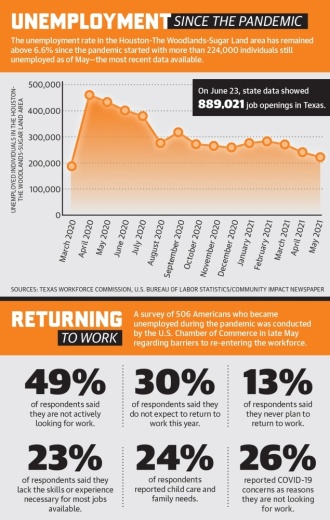“When we respond to people who send out an application, one out of 10 of them responds back, and if we set up an interview, one out of 50 actually shows up,” he said. “It is very, very difficult to find people.”
Raffa’s struggle to find new employees matches trends seen throughout Texas as employers grapple with a number of issues precluding them from securing new hires. According to data provided by the Texas Workforce Commission, Texas’ unemployment rate in May was 6.5%—up from the prepandemic unemployment rate of 3.4% in May 2019.
Despite restaurants being allowed to fully reopen in March, Rosa Perez, owner of Sharky’s Waterfront Grill and Chimichurri’s South American Grill in Kingwood, said her establishments are operating with roughly half of the staff they had pre-pandemic.
“Since before [March], we had been looking for staff, thinking we need to get ready for when we do go back to 100%, and we’ve been struggling with this for months,” Perez said. “We can’t necessarily go back to 100% when we don’t have enough staff.”
Perez said she estimates her restaurants are losing close to $10,000 a week in sales because she does not have enough employees to run them at full capacity.
“People are excited to get back out because we see the traffic coming through, but then we have to stop them at our doors,” Perez said. “They get upset, and there’s nothing we can do about it. It’s a struggle.”
Contributing factors
Patrick Jankowski, senior vice president of research at the Greater Houston Partnership, said employers are struggling to find workers in almost every sector of the local economy.
“There’s definitely a labor shortage,” Jankowski said. “The causes of the labor shortages are somewhat in dispute, but a significant portion is the fact that we were given very generous unemployment benefits.”
Last year, unemployment benefit eligibility was temporarily extended as part of the federal Coronavirus Aid, Relief and Economic Security Act’s Pandemic Unemployment Assistance program, and an additional $300 in benefits per week was given to those who qualified.
“The average unemployment benefit in the U.S. is $346 a week,” Jankowski said. “If you’re unemployed and you’re getting the average benefit, plus the additional $300, you’re making $16.15 an hour just to stay home.”
In May, Gov. Greg Abbott announced Texas would opt out of the extra $300 per week after June 26.
Jankowski said while he believes the reduced unemployment benefits would spur hiring, it would be difficult to determine how much of an effect it will have on hiring until July employment data is released in August.
Raffa said he believes expanded unemployment benefits and stimulus checks have factored into the difficulty of finding new workers, but he also said many of his former employees found jobs in other industries after restaurants scaled back due to COVID-19 restrictions.
Melissa Stewart, regional executive director for the southeast region of the Texas Restaurant Association, said losing workers during the pandemic was common across the industry.
“When a lot of restaurants had to reduce their workforce because they did not know what was going to be happening in April and May of 2020, many of our workers left the industry,” Stewart said. “They didn’t go on unemployment. They didn’t have that option. They left us and went almost directly to something else, and usually that was a retail or another kind of service job. ... Those folks are no longer in the workforce pool.”
Stewart noted of the approximate 86,000 people in the Greater Houston area enrolled in unemployment benefits, fewer than 1,100 were identified as coming from the hospitality industry.
Raffa said, however, he has seen an uptick in responses to his employment ads since the additional unemployment benefits ended June 26; he has since been able to hire two new employees.
Perez, on the other hand, said she is still struggling to hire new workers for both of her restaurants.
“I was thinking, if the unemployment [benefits are] over and done with, we’ll get a whole wave of people coming in, but we haven’t,” Perez said. “We don’t know what’s going on or how much longer we’re going to be able to deal with this.”
Looking for solutions
Jankowski also said a lack of child care options has affected people’s ability to seek employment.
“Day care is still a significant issue in this state,” Jankowski said. “A lot of day cares closed because of fears of COVID. Parents pulled their children out. Although we’re seeing a large number of those reopen, a fourth of all day cares that closed during COVID are still closed.”
In May, Texas lawmakers failed to pass a bill that would have funded virtual learning throughout the state, meaning most students will be back in classrooms this fall. Jankowski said he believes there will be a boost in employment numbers when schools reopen and parents no longer need to stay at home with their children.
Jonathan Lewis, senior policy analyst with nonprofit Every Texan, said more people will gain employment when they find jobs that meet their skillsets and needs—including increased wages.
“I think the narrative has really been altered to make it seem like workers are choosing not to work, but I think the reality is people do want to get back to work,” Lewis said. “It takes time to find the right match for workers and employers, so I think this is to be expected that it would take a little bit of time for folks to find positions that are suitable for them and that match their skills and the requirements that they have for a job, be it location, hours [or] ... pay.”
According to Perez, many of the people who have applied to her restaurants were not well suited for the positions.
“We get people interested who have no experience, as far as a bartender who’s never bartended before,” she said. “People need to know how to make a drink if they’re going to work in a bar.”
To reduce turnover, Perez raised her kitchen staff’s hourly wage by as much as $2 in some positions, although she noted that increase has not landed her any new employees.
“I was thinking when we went up some [in pay] that we would find other employees, but it looks like people don’t want to work yet,” she said.
Anna Lotz and Brooke Ontiveros contributed to this report.







